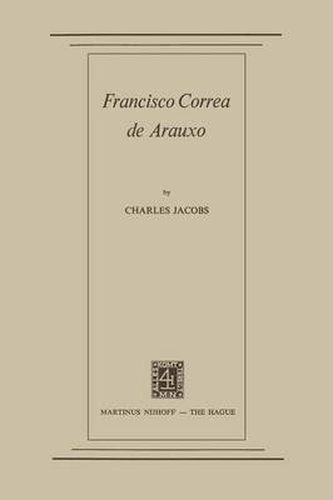Francisco Correa de Arauxo
Charles Jacobs

Francisco Correa de Arauxo
Charles Jacobs
This title is printed to order. This book may have been self-published. If so, we cannot guarantee the quality of the content. In the main most books will have gone through the editing process however some may not. We therefore suggest that you be aware of this before ordering this book. If in doubt check either the author or publisher’s details as we are unable to accept any returns unless they are faulty. Please contact us if you have any questions.
Francisco Correa de Arauxo: how little does the name evoke for most musicians? Yet, this composer wrote music equal in interest and beauty to that of such better-known composers of his time as Bull, Titelouze, Gibbons, Sweelinck, and Frescobaldi. Unfortunately, Correa’s music was published in a notation which, though excellent, was little-known beyond Spain. Only within the last twenty years has a complete -though regrettably deficient - edition of Correa’s music become available. Cabezon, Correa de Arauxo’s most significant immediate predecessor on the Hispanic musical scene (at least among keyboard composers whose music survives to any extent), figures among the greatest and most influential Renaissance composers. In Cabezon’s works, the ricer- car (known as tiento in Spain) and variations forms reached full de- velopment. Manuel Rodrigues Coelho, Correa’s Portuguese contemporary, al- though working well into the seventeenth century, did not venture beyond the formal boundaries established by Cabezon. On the other hand, a number of late sixteenth-century Spanish composers - Francisco Peraza, and others whose works seem irretriev- ably lost - apparently were writing music that incorporated into the contrapuntal flow of the tiento toccata-like episodes. The result, for- mally, was similar in many respects to toccatas of late-Renaissance Italy. Formal sectionality also appears in the late sixteenth-century Italian ricercar, particularly in those known as canzone francese. This formal trait is present in music by composers of Naples, then under Spanish dominion, and Venice. Correa could not have been working in cultural semi-isolation.
This item is not currently in-stock. It can be ordered online and is expected to ship in 7-14 days
Our stock data is updated periodically, and availability may change throughout the day for in-demand items. Please call the relevant shop for the most current stock information. Prices are subject to change without notice.
Sign in or become a Readings Member to add this title to a wishlist.

